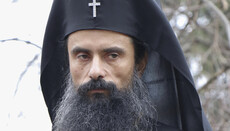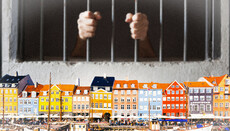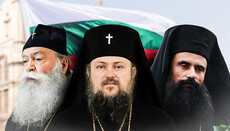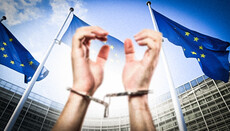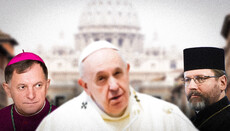Does UGCC plus OCU equal to "one church"?
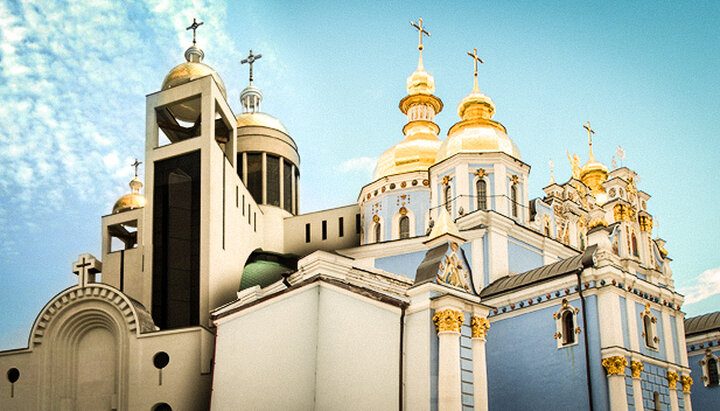
A conference of the UGCC and the OCU was held in Kyiv, which may be the start of unification of these religious organizations. We analyze speeches and draw conclusions.
On October 26, 2021, representatives of the UGCC, Phanar and the OCU held an international ecumenical conference in Kyiv “Catholic-Orthodox Documents and Their Reception in Ukraine”. The Ukrainian translation of the documents of the Orthodox-Catholic dialogue over the past 40 years was presented there alongside big pronouncements – so big that one gets the impression that the whole conference was about voicing them, rather than presenting a thin brochure about the Orthodox-Catholic dialogue. Does this mean the run-in of the project of unification of the Vatican and Phanar in Ukraine has entered its practical stage? We are trying to figure it out.
Conference: who was present and who was absent
Before looking at the personal composition of the participants, it should be noted that the initiators of the conference are in fact the Vatican (as the governing body of the entire Catholic Church) and Phanar (as the governing body of the Patriarchate of Constantinople), which also have religious structures subordinate to them in many countries. In Ukraine, there is the Ukrainian Greek Catholic Church, subordinate to the Vatican, and the Orthodox Church of Ukraine, subordinate (albeit not so obviously) to Phanar. Therefore, in order for this conference to be held at a serious level, both the OCU and the UGCC had be represented at it, as well as their main structures: the Vatican and Phanar.
Phanar was represented by the Exarch of Constantinople to Ukraine, Bishop Mikhail (Anishchenko). He is the titular bishop of Comana (i.e., the bishop of a non-existent diocese), the head of the stavropegia of the Patriarchate of Constantinople and the rector of St. Andrew's church in Kyiv. Archbishop Job (Getcha) took part in the conference in absentia, and his message was read out at the meeting.
The Vatican was represented by the Apostolic Nuncio in Ukraine, which since June 2021 is the Most Reverend Visvaldas Kulbokas, titular Archbishop of Martana. True though, Monsignor Kulbokas was represented in absentia, on his behalf the welcoming address was read by the head of the UGCC Commission for the Promotion of Christian Unity Igor Shaban.
The UGCC was represented extensivley and at the highest level. It was attended by the head of the Ukrainian Catholics of the Orthodox rite, Sviatoslav Shevchuk, accompanied by Ivan Datsko, President of the Institute for Ecumenical Studies of the Ukrainian Catholic University, the aforementioned Igor Shaban, and Petro Zhuk, rector of the Kyiv Seminary, and others.
But the OCU was represented only by Georgy Kovalenko, former archpriest of the UOC, banned from ministry, who is also the head of the "Open Orthodox University of St. Sophia the Wisdom". This university bears approximately the same titular character as the diocese of Comana, and the adjective "Orthodox" in its name is hardly justified, since it bears a pronounced ecumenical character. Actually, this is not a university at all, but "... a non-governmental and non-political association of believers of different religions and confessions ..." as stated on its website.
It is also worth noting the presence of Kirill Govorun at the conference, a freelance cleric of the Moscow Diocese of the Russian Orthodox Church, who directly participated in the work of the Mixed Commission on Orthodox-Catholic Dialogue.
The only important figure absent at the conference was the head of the OCU, Sergei (Epiphany) Dumenko. This is very surprising, because the idea is to unite the UGCC and the OCU. And since the head of the former organization was present, then, according to all diplomatic rules, the head of the latter should have been present too. However, S. Dumenko ignored the event and did not even send any of his "bishops". Moreover, he did not have any serious commitments on that day. According to the website of the OCU, S. Dumenko met with Svetlana Kagamlyk, a senior researcher at the Faculty of Philosophy of T. Shevchenko KNU, as well as with acting President of the Kyiv-Mohyla Academy Alexandra Gumenna. These meetings were hardly more important than the issue of unification with the UGCC. Why did this happen?
The fact is that S. Dumenko cannot but understand that the unification of his structure with the UGCC will not be on a par. This will actually mean the absorption of the OCU by Ukrainian Catholics of the Orthodox rite, and S. Dumenko's place in this united structure will not be the first.
Nevertheless, it should be said that literally on the eve of the conference, Mikhail Zinkevich, one of the most respected "bishops" of the OCU, who was supposed to head this structure (if it hadn’t been for Filaret's demarche at the "Unification Council"), supported the unification with the Uniates.
“We want to see a united church, where there will be no Moscow Patriarchate, no Greek Catholics, no OCU, but there will be one big Ukrainian church instead. Without all these names. It should be called the Ukrainian Orthodox Church. No additions, no modifications, no formats – just the church of the Ukrainian people, and that's it," Zinkevich said on October 23.
What was presented at the conference
A small brochure was presented there. See below.
The fact that this meeting is only an excuse to make big prnouncements on unification is evidenced by the fact that this "Catholic-Orthodox dialogue" is in fact a legacy of the Soviet era and rather an unsuccessful project.
Preparations for the start of the Orthodox-Catholic dialogue began in 1961. As a result of several Pan-Orthodox conferences, it was decided to propose to the Roman Catholic Church to start "a dialogue between the two churches on equal terms." Later in 1967, the Patriarch of Constantinople Athenagoras (Spiru) and Pope Paul VI announced that the two Churches intend to conduct a "dialogue of love" and a "dialogue of truth" that complements it. Not long before that, they "lifted" the mutual anathemas imposed in 1054. It must be said that the Russian Orthodox Church rather actively participated in this Orthodox-Catholic dialogue, but not because of the good life. The fact is that the beginning of this dialogue coincided with a large-scale persecution of the Church under N. Khrushchev, who promised to show the last priest on TV in 20 years. The persecution was rather severe, as historian Vladimir Stepanov writes: "The totality of the persecution was supposed to create an atmosphere of rejection, cultural isolation for believers, amid which they would feel like second-class citizens, social outcasts unworthy to enter a bright future together with the other people." Whether or not it was justified to make compromises in matters of faith under those conditions is subject to an additional consideration, but by its activity in the international arena the ROC in those years simply tried to survive.
In 1979, the Joint International Commission for Theological Dialogue between the Orthodox Church and the Roman Catholic Church was established. This was preceded by several meetings of the Inter-Orthodox Theological Commission, which adopted a number of controversial documents. For example, in 1978 in Chambesy, a document was adopted in which the goal of the Orthodox-Catholic dialogue was worded as “the establishment of full communion between the two Churches <...>, which, on the basis of the unity of faith, common life and common tradition of the ancient Church, will find its expression in the joint celebration of the Eucharist.” Formally, this meant a return to the common faith and tradition of the first millennium, but in reality it meant a policy of compromise and conciliation.
Since 1980, the Joint International Commission has held 14 meetings, at which documents were adopted on various aspects of the Orthodox-Catholic dialogue. These documents were not accepted as binding by either the Catholic Church or the Local Orthodox Churches; they remained documents of the Mixed Commission. Some of them, such as the 1997 Balamand Declaration or the 2007 Rabbinic Document, caused a backlash with most Local Churches. All these documents, translated into Ukrainian, basically became the content of the aforementioned brochure.
At this stage, the Orthodox-Catholic dialogue is under serious criticism. Catholics express the opinion that the principle of the supremacy of the Roman pontiff is not sufficiently defended in it, the Orthodox reject excessive ecumenism, but the Uniates are the most dissatisfied, and not only Ukrainian ones. A little bit more about it below.
Bombastic declarations
So, what did the main participants of the conference say?
The head of the UGCC, Sviatoslav Shevchuk, repeated the provisions of the 1979 document of the Mixed Commission on the purpose of the Orthodox-Catholic dialogue: “I think everything is said here. The goal of ecumenical dialogue is not just to cooperate, but to restore communion. We need to say loudly today that Orthodox Christians and Catholics, Greek Catholics do not mutually curse themselves anymore, we consider ourselves brothers and sisters in Christ, and we are looking for ways to restore the lost unity between Christians." It’s noteworthy that very often the concept of anathema (at least the Orthodox one) is used for manipulation. Anathema is not a curse in the sense that someone who falls under it is supposed to burn in hell or to have rough time in their life. This is a statement of the fact that a person or a church community, by their wrong-thinking, heresy or something similar, has set themselves outside the Church of Christ, the only ship of salvation. Therefore, the Orthodox Church has never cursed Catholics, but testified that their errors are incompatible with their being in the Church.
Sviatoslav Shevchuk also declared that the UGCC would embody all the achievements of the ecumenical dialogue between the Roman Catholic Church and Orthodoxy. “We want to apply everything that has been achieved in the Orthodox-Catholic dialogue at the universal level at our local level in Ukraine,” said the head of the Ukrainian Uniates.
This statement is rather ambiguous, since in the relevant documents of the Mixed Commission the union is recognized as a historical mistake. The same Balamand Declaration states that the parties reject union as a method of seeking unity, since it "contradicts the common tradition of the churches" and that "union cannot serve as a model for the unity of the Churches either in the present or in the future."
Apostolic Nuncio in Ukraine Visvaldas Kulbokas urged to move from theoretical speculations to practical steps: “Noticing the success of this dialogue, it becomes obvious that the path we followed was correct. But efforts need to be made to implement its practical and concrete representation at the local level, so that it does not remain only theoretical entertainment." Is this a beautiful wording or a hint that these very practical steps will follow in the near future? The overall situation in the religious sphere both in Ukraine and at the global level suggests that if the Vatican and Phanar really decided to unite, then the trial balloon of such unification will be thrown in our country.
The fact that it is most convenient to implement this in Ukraine is also evidenced by the words of the Exarch of Constantinople, Bishop Mikhail (Anishchenko), who said that “a unique situation has been created in Ukraine, since several Christian traditions and jurisdictions are powerfully represented at once.” True, the Orthodox will have to rethink their theology for this. “The Orthodox-Catholic dialogue revives intra-Orthodox theological thought, as it makes it necessary to seek answers to acute theological issues and to thoroughly re-examine its own history and theological heritage,” said the Exarch of the Patriarchate of Constantinople. Indeed, in order to continue the Orthodox-Catholic dialogue, Orthodox Christians need to “thoroughly rethink” their theology, since it does not allow uniting with heretics if they continue to adhere to their delusions. Perhaps, as a result of these "careful studies", the supporters of this approach will be able to find individual quotations that speak in their favor, but on the whole, the Orthodox doctrine unequivocally testifies: "Warn a divisive person once, and then warn them a second time. After that, have nothing to do with them. You may be sure that such people are warped and sinful; they are self-condemned" (Tit. 3:10). Regarding the approach for which Bishop Mikhail (Anishchenko) stands up, St. Gregory of Nyssa best said: “As an originator of poisons makes a poison edible for a poisoned person, sweetening it with honey, and just gives the poison, but then the poison, mixed into the entrails, produces destruction without any participation of the originator of the poison; something similar <...> is done by heretics. With refined reasoning, as if with poison, they sweeten <...> the deadly doctrine ..."
To continue the Orthodox-Catholic dialogue, the Orthodox need to “carefully re-examine” their theology, since it does not allow uniting with heretics if the latter continue to adhere to their delusions.
Also, the head of the stavropegia said that "the Orthodox-Catholic dialogue and the search for ways to restore unity is also relevant for the preservation of unity in the Orthodox Church itself." These words become clear if we remember that the unity of the Church is understood by the Phanariot bishops as a unity under the leadership of the Patriarch of Constantinople. This was personally stated by Patriarch Bartholomew while on a visit to the United States: "We are obliged to lead the Local Autocephalous Churches as an elder brother of one family."
Anyway, the most revealing confession was made by Bishop Mikhail (Anishchenko) as he said the following words: "The most pressing issue for both Orthodox Christians and Catholics today is the issue of primacy implementation in the Ecumenical Church." That is, not the filioque heresy, nor the dogmas invented by the Catholics about purgatory, the Immaculate Conception of the Most Holy Theotokos, nor the legal theory of salvation, nor the prayer practice, which, from the point of view of the Orthodox holy fathers, is a delight – none of this hinders rapprochement. Discussions are conducted only around who will be the "first" and how this "primacy" will be implemented despite the fact that this issue was closed by Jesus Christ. “They came to Capernaum. When he was in the house, he asked them, “What were you arguing about on the road?” But they kept quiet because on the way they had argued about who was the greatest. Sitting down, Jesus called the Twelve and said, “Anyone who wants to be first must be the very last, and the servant of all” (Mark 9: 33-35).
Will Phanar and RCC get united in Kyiv?
The above mentioned Mikhail (Anishchenko) frankly said about the ultimate goal of the dialogue between the RCC and Phanar: “This (brochure on the dialogue – Ed.) is more than a wonderful publication, but it is only a tool serving the ultimate goal, the goal being the search for unity. Restoration of unity, pardon, not a search."
Ivan Datsko, President of the Institute of Ecumenical Studies of the Ukrainian Catholic University, specified the time frame for achieving this goal: “I would like to restore full communion between the Catholic and Orthodox Churches by 2025. This is our main objective." He also said that such a goal should be realized precisely here, in Ukraine: “For two years so many positive changes have accumulated in the Orthodox Church of Ukraine, and I say – in the Ukrainian Orthodox Church, in Ukrainian Orthodoxy, that if we, Ukrainians, Christians miss this opportunity, then we will commit a great sin against our church and people." He explained that under Pope Francis and Patriarch Bartholomew of Constantinople, “we have come so close that if not now, then – I don’t want to say it – never. We will be missing out on a huge opportunity."
Datsko also put on the agenda the issue of electing a single patriarch for the united UGCC-OCU. “I am convinced that the future Ukrainian patriarch needs to be elected by both Orthodox and Catholics. One, we do not need 5-10 patriarchates in Kyiv, one and all. But we must make joint efforts to take the Eucharist of love together, and then elect,” he said.
The President of the Institute of Ecumenical Studies of the UCU briefly outlined the program theses for the unification.
- Common prayer.
- Common baptism.
- Unified translation of the liturgy and the Gospel.
- Desire for mutual reconciliation and forgiveness.
- Avoiding historical claims to each other.
One may ask: what about the dogmas that divide the Orthodox from the Catholics?
Setting out his theses, Datsko said in one of the clauses: "We are studying the positions of the Orthodox and Catholic Churches on the issue of the primacy of the bishop of Rome, because this is most divisive." How the study of positions (which have already been studied for almost 1000 years) will help solve this problem – the conference did not say. It seems that no one considers this problem to be a problem. Participants in the meeting call the dividing dogmas "stereotypes". The same Datsko, referring to the filioque (heresy of the Catholics about the Trinity dogma), said: "With or without filioque, take it easy."
But that is not all. The conference participants, starting with Sviatoslav Shevchuk, used the word "ecumenism" in an exclusively positive sense as a factor uniting Christians. However, there was an episode at the meeting which indicates that the “Christian unification” is not the final stop on this route.
As the crux of the biscuit, one can cite the narrative of Lyudmila Filipovich, religious scholar, professor, head of the Department of Philosophy and History of Religion at the Hryhoriy Skovoroda Institute of Philosophy of the National Academy of Sciences of Ukraine. Talking about the Trinity Theological Seminary of the UGCC, she said that future Uniate priests are brought up there "in the spirit of interreligious understanding". “This is the only spiritual educational institution in Ukraine where a course of practical religious studies is taught, within the framework of which we annually go with seminarians not only to other Christian denominations, but also to Jews, Muslims, Sahaji Yogis, Bahá'ís and so on in general,” said L. Filipovich. Well, this is quite consistent with the modern views of Pope Francis, who allows worshiping the pagan idol of Pachamama and reading pagan prayers to him.
Conclusions
First, the results of this conference should be treated in the same way as the results of the Mixed Commission on Theological Dialogue, the documents of which were presented at the conference. Both those and other results are not mandatory for anyone and do not necessitate any further events. However, they can become a favorable background for some practical action to unite the UGCC and the OCU, if such a decision is officially adopted by the Vatican and Phanar.
Secondly, the unification of the UGCC and the OCU serves primarily the interests of the Uniates, since any union is a union in favor of Catholicism, as evidenced by the history of all the unias.
Thirdly, events in the world are now developing very rapidly in all spheres, including the religious one. Therefore, whether an attempt to unite the UGCC and the OCU will be implemented, we will find out pretty soon.
Fourthly, if events develop exactly according to this scenario, we can safely say that the Ukrainian authorities will not stand aside and will do everything possible so that such a union becomes not only possible, but also absorbs as many communities of the Ukrainian Orthodox Church as possible. Now it seems too fantastic, but the events that preceded the creation of the OCU show that it is quite possible. Then P. Poroshenko, using the administrative resourse and, above all, the law enforcement agencies, by hook or by crook tried to drive as many bishops of the UOC as possible into the OCU. After the creation of the OCU, they tried to drive as many UOC communities as possible into it. The likelihood that this will happen again and reach a more violent level is very high. If a united UGCC-OCU is created, its support from the state will reach a qualitatively new level, as it will reach a new level and pressure on the UOC. For example, it will be very difficult to retain the Kyiv-Pechersk and Pochayiv Lavras.
Fifth, everyone who decides to join this united UGCC-OCU must be aware of the fact that ecumenism awaits them in the future not only with Catholics, but also, figuratively speaking, with Pachamama.
Still, be that as it may, the current union will turn out to be as disastrous as all the previous ones in the end. This is evidenced by both the history of the Church and the words of the Lord Jesus Christ: "I will build my Church, and the gates of Hades will not overcome it ..." (Matt. 16:18).

